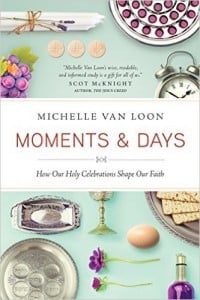The Jewish feasts. The Christian calendar. Which one should form our worship?
 The answer isn’t so simple. As I noted in Moments & Days: How Our Holy Celebrations Shape Our Faith, it behooves us all to learn a little something about each calendar – and then begin allow the rhythm of one to shape our discipleship journey, one day at a time.
The answer isn’t so simple. As I noted in Moments & Days: How Our Holy Celebrations Shape Our Faith, it behooves us all to learn a little something about each calendar – and then begin allow the rhythm of one to shape our discipleship journey, one day at a time.
I’m offering in this space one small, do-able step here in this space you, your family, small group, or church can use to move their learning from the page to life about each holy day, along with one recipe you may wish to try. There are a few recipes in the back of Moments & Days, but the recipes you’ll find on this blog didn’t make it into the book.
Today, we’ll be looking at Sukkot, also known as the Feast of Tabernacles, or Booths. The eight-day feast begins at sundown, Sunday, October 16th, and concludes the evening of Sunday, October 23rd. For a 5-minute overview of the holy day, click here.
 Sukkot, or the Feast of Tabernacles, is the final feast of the yearly festal cycle. It comes just five short days after Yom Kippur, and is marked by the construction of little temporary dwellings, booths – or sukkahs, in which families are supposed to live and eat for 8 days. The holiday is joyous, hopeful and marked by an intense focus on hospitality. Sukkot is also known as the Feast of Ingathering. While the name stirs images of agricultural harvest time, it actually points forward, toward the time when God’s people from every tongue, tribe, and nation will be gathered to him (Revelation 5:9). Sukkot invites us to savor each year the sweet promise of ingathering as our penultimate family reunion.
Sukkot, or the Feast of Tabernacles, is the final feast of the yearly festal cycle. It comes just five short days after Yom Kippur, and is marked by the construction of little temporary dwellings, booths – or sukkahs, in which families are supposed to live and eat for 8 days. The holiday is joyous, hopeful and marked by an intense focus on hospitality. Sukkot is also known as the Feast of Ingathering. While the name stirs images of agricultural harvest time, it actually points forward, toward the time when God’s people from every tongue, tribe, and nation will be gathered to him (Revelation 5:9). Sukkot invites us to savor each year the sweet promise of ingathering as our penultimate family reunion.
(To Try)
If your family or small group is interested in a Sukkot experience, planning a casual harvest-themed potluck is a simple way to begin. Make sure your feast includes reciting some or all of Psalms 113–118 together. And invite a few people from outside your usual circle to join you around your table.
If you live in a town with a synagogue in it, why not see if you can make arrangements to visit their congregational sukkah? The experience of standing inside of one will give you a far better picture of the holiday’s central image than words can. Your family, small group, or children’s Sunday school class may want to try building a sukkah. You can search online for some simple building and decorating instructions.
The sukkah is the central motif of this feast. The experience of living in booths underscores the pilgrim status of the Chosen People. But Sukkot is far more than a living history lesson reminding them of their 40 years of living in temporary dwellings – sukkahs – after the exodus for 40 years in the desert. Sukkot is a promise that we will welcome the king to dwell among us!
More than any other Jewish holiday, Sukkot carries with it the promise of a future Messianic fulfillment for not-yet-believing-in-Jesus Jewish people. For generations, Jewish worshippers read key Scripture passages pointing toward this promise, including the description of God’s glory filling the temple during its consecration (1 Kings 8) and Zechariah’s prophecy of a final day when even those who were once enemies of God would celebrate Sukkot (Zechariah 14). When temporal time comes to an end, God will again dwell with humanity the same way he did in Eden.
And I heard a loud voice from the throne saying, “Look! God’s dwelling place is now among the people, and he will dwell with them. They will be his people, and God himself will be with them and be their God. ‘He will wipe every tear from their eyes. There will be no more death’ or mourning or crying or pain, for the old order of things has passed away.” He who was seated on the throne said, “I am making everything new!” (Rev. 21:3-5)
(To Eat)

Sukkot is a feast of abundance and hospitality. In some circles, stuffed foods like stuffed cabbage, peppers, or squash are traditional as a way of celebrating this abundance. But otherwise, the sky’s the limit when it comes to a Sukkot table.
I found a simple recipe that honors the notion of a land flowing with milk and honey, a way in which God described the Promised Land to Moses (Exodus 3:17). It is a perfect summer-through-early-fall appetizer, and a lovely way to savor the hope of this holiday.
Challah Bruschetta with Lemon Ricotta and Honey
Adapted from Tori Avey’s recipe
- 1 large or 2 small fresh lemons
- 2 cups high quality whole milk ricotta cheese (about 15 oz.)
- 1/2 medium challah loaf, unsliced
- Quality extra virgin olive oil
- 1 large garlic clove, crushed
- Sea salt, white pepper to taste
- Light colored honey
Zest the lemon. Set aside the zest in a small bowl. Juice the lemon(s).
In another bowl, combine the ricotta, salt, pepper, and lemon juice. In a small dish, combine crushed garlic and olive oil.
Slice the challah into thick slices, and brush liberally with garlic-olive oil mixture. Grill or broil the challah until browned and crispy. Smear a dollop of the ricotta mixture atop the challah, then top with reserved lemon zest and a drizzle of honey. Serve immediately.











